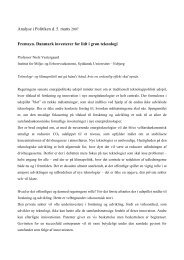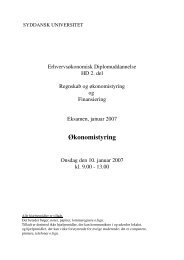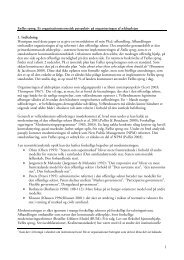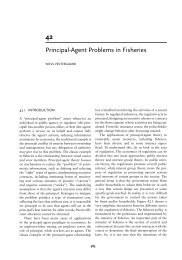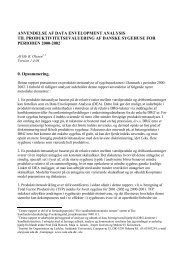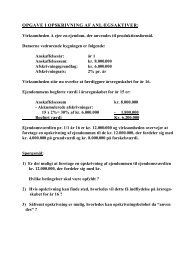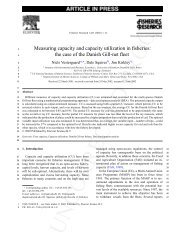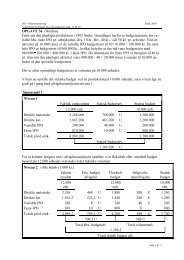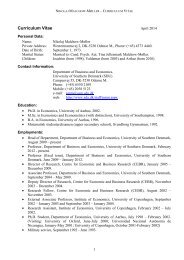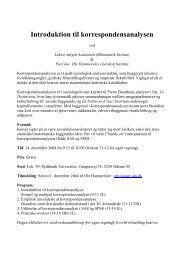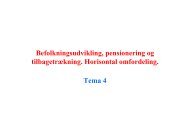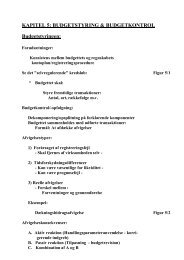group. RS AWS constituted the Christian-democratic l<strong>in</strong>e, ZChN the Christian-national <strong>and</strong> SKLthe liberal-conservative.From the beg<strong>in</strong>n<strong>in</strong>g the organisational structure was heavily debated. Thus Aleks<strong>and</strong>er Hall arguedthat AWS’ organisational structure was at the same time too odd <strong>and</strong> amorphous, because AWS wascomposed <strong>of</strong> too different <strong>and</strong> ”fictitious” organisations, result<strong>in</strong>g <strong>in</strong> several less successfulattempts to centralize decision-mak<strong>in</strong>g. The close cooperation between workers <strong>and</strong> <strong>in</strong>tellectualsthat <strong>in</strong> the 1980s gave Solidarity considerable political strength, ceased to exist both <strong>in</strong>side the tradeunion Solidarity <strong>and</strong> the electoral alliance (RS AWS). Soon after the democratic break-through,most <strong>in</strong>tellectuals took the decision to jo<strong>in</strong> the liberal Democratic Union (UD), the later FreedomUnion (UW).At the beg<strong>in</strong>n<strong>in</strong>g it was difficult to estimate, to what extent AWS could be reshaped <strong>and</strong> after thatconstitute a functional <strong>and</strong> discipl<strong>in</strong>ed party, but that was not likely to happen. Inside so broad amovement like AWS it was important, but difficult to determ<strong>in</strong>e the political <strong>in</strong>fluence <strong>of</strong> eachgroup <strong>and</strong> to s<strong>in</strong>gle out the ma<strong>in</strong> political decision centres, the political core (”nurt”). After thewithdrawal <strong>of</strong> the right w<strong>in</strong>g KPN from AWS the fundamentalist conservative-traditionalist factionsbecame weaker. Nonetheless, most decisions could only be taken on the central level <strong>and</strong> afterprotracted negotiations. In most cases decisions were taken accord<strong>in</strong>g to the slogan ”the higher (<strong>in</strong>the organisation), the more politics”, but far from all decisions were implemented at the local level<strong>and</strong> <strong>in</strong>side each political group <strong>and</strong> “leg”. At least formally, the decision mak<strong>in</strong>g procedures weretop-down, but this did not mean that AWS constituted a homogeneous <strong>and</strong> functional partyfederation.The political rhetorique became still more anti-communist. From the outset AWS appeared as anidentity party without consistent political programme <strong>and</strong> sufficient <strong>in</strong>stitutionalisation aim<strong>in</strong>g tocome to power as fast as possible. The mobilization <strong>of</strong> the old Solidarity-ideals was re-activatedbefore the 1997 election. The election campaigns were moral-ideological <strong>and</strong> marked by symbolicpolitics. The strong resistance aga<strong>in</strong>st liberal abortion rules has repeatedly been put forward, alsodem<strong>and</strong>s <strong>of</strong> more support for families <strong>and</strong> approval by the parliament <strong>of</strong> the concordat with thechurch, <strong>and</strong> ”decommunisation” (”dekomunizacji”) <strong>in</strong>clud<strong>in</strong>g a purge <strong>of</strong> collaborators from the oldsystem.AWS concentrated its efforts on three policy levels: the break with the communist past, the creation<strong>of</strong> a new ”healthy” (”zdrowy”) state separat<strong>in</strong>g state from economy <strong>and</strong> supported by pr<strong>of</strong>oundpolitical, social <strong>and</strong> economic reforms. As said, subjects such as appo<strong>in</strong>tments <strong>of</strong> new people toimportant posts <strong>in</strong> society, abortion, decommunisation, the concordat with the church, privatisation<strong>and</strong> a new constitution were all placed high on the political agenda. Thus, the ”we versus them”dist<strong>in</strong>ction was still given high priority. Solidarity put forward its own proposal dur<strong>in</strong>g thediscussions about the new constitution, that once aga<strong>in</strong> reflected the classical religious <strong>and</strong>“syndicalist” values. A revision <strong>of</strong> the constitution, however, was not a part <strong>of</strong> the agreement,lead<strong>in</strong>g to the formation <strong>of</strong> the AWS <strong>and</strong> The Freedom Union (UW) government after the 1997-election.Consider<strong>in</strong>g the big social <strong>and</strong> economic problems <strong>in</strong> society too little attention was paid to socialissues. Mov<strong>in</strong>g to more ord<strong>in</strong>ary politics to dissociate oneself from the (”post-) communists” wasno guarantee <strong>of</strong> electoral success. Should Solidarity survive <strong>in</strong> the shape <strong>of</strong> a functional politicalparty federation, more “down-to-earth” political questions had to be <strong>in</strong>cluded. The majority <strong>of</strong> the58
electorate asked for more honesty <strong>in</strong> politics, a policy-orientated l<strong>in</strong>e with clear mark<strong>in</strong>g on politicalissues appeal<strong>in</strong>g to the “average voter”, e.g. ways <strong>of</strong> collective barga<strong>in</strong><strong>in</strong>g, work<strong>in</strong>g conditions,employment service, social assistance, legal support to the members <strong>and</strong> <strong>in</strong>fluence onrestructuration <strong>of</strong> enterprises. For most Poles the years under state socialism belonged to the past. Inthe long run Solidarity could not survive only on the foundation myth, the memories <strong>and</strong> feel<strong>in</strong>gsgo<strong>in</strong>g back to the fight aga<strong>in</strong>st the old system, but old discourses from the 1980’s were never “defreezed”.Nevertheless, the presidential election 2000 showed that the old anti-communist politicalslogans appealed to a small part <strong>of</strong> the electorate, between 10 <strong>and</strong> 15 pct. <strong>of</strong> the voters. The lack <strong>of</strong>de-freez<strong>in</strong>g <strong>of</strong> the old “we-them” discourse on elite level turned out to be most beneficial to theLeft.The attitudes to the communist past divided the right w<strong>in</strong>g camp. Different op<strong>in</strong>ions existed on howseverely former communist <strong>and</strong> agents <strong>of</strong> the old system should be treated by the authorities.Mazowiecki’s wish to draw a ”thick l<strong>in</strong>e” (between the past <strong>and</strong> present) was met with the greatestsupport <strong>in</strong> the Freedom Union (UW). Only few <strong>in</strong> AWS shared the op<strong>in</strong>ion that “reckon<strong>in</strong>g withthe past” should be structural, not based on the dem<strong>and</strong> <strong>of</strong> revenge. The “s<strong>of</strong>t l<strong>in</strong>e” to the past wasexpressed <strong>in</strong> the Polish daily ”Gazeta Wyborcza” <strong>and</strong> not least by its editor-<strong>in</strong>-chief Adam Michnik.Some problems were policy-related. Thus the health reform was both badly <strong>in</strong>troduced <strong>and</strong>implemented. The citizens were not adequately <strong>in</strong>formed about the consequences <strong>of</strong> the reform, e.g.which parts <strong>of</strong> health services that would be cut down after <strong>in</strong>troduction <strong>of</strong> the reform. Furthermore,no answer was given on the crucial question, who would w<strong>in</strong> <strong>and</strong> who loose because <strong>of</strong> the reform.As a consequence <strong>of</strong> that, no suitable analysis <strong>of</strong> the impact <strong>of</strong> the reform for different social groupswas conducted. Thus, accord<strong>in</strong>g to public op<strong>in</strong>ion polls conducted two years after <strong>in</strong>troduction <strong>of</strong>the reform the majority <strong>of</strong> the Polish people shared the op<strong>in</strong>ion that the health reform taken as awhole constituted a big step backwards.The development <strong>of</strong> AWS confirms the hypothesis that broadly based negative election alliancesare hardly able to transform themselves <strong>in</strong>to homogeneous <strong>and</strong> functional party-federations. Only awell- developed party culture <strong>and</strong> <strong>in</strong>stitutionalisation <strong>and</strong> sufficient loyalty <strong>and</strong> cohesion on actorlevel can “keep a parties together” <strong>and</strong> provide them with a sufficient ”immune defence” <strong>in</strong> case <strong>of</strong>political crisis <strong>and</strong> set-backs. Both factors, <strong>in</strong>stitutionalization <strong>and</strong> elite cohesion, were absent <strong>in</strong> thecase <strong>of</strong> AWS. This implied that the risk <strong>of</strong> new splits on the Right existed ever s<strong>in</strong>ce the foundation<strong>of</strong> AWS <strong>in</strong> 1996.To conclude, AWS expressed a return to the polarised historical division <strong>of</strong> Polish society,express<strong>in</strong>g, as put by Michal Wenzel, ”a return with considerable differences” 47 . The values, onwhich Solidarity was established, were not those championed <strong>in</strong> the late 1990’s. Neither <strong>in</strong> theshape <strong>of</strong> a trade union nor a political party Solidarity reflected the consensus seek<strong>in</strong>g <strong>and</strong> at thesame time combat<strong>in</strong>g Solidarity 20 years back. As said, the old dist<strong>in</strong>ction, civil society aga<strong>in</strong>sttotalitarianism, the lack <strong>of</strong> ability to go beyond culture <strong>and</strong> history <strong>and</strong> <strong>and</strong> solve problems onprogramme <strong>and</strong> policy level, underm<strong>in</strong>ed the position <strong>of</strong> Solidarity’ <strong>in</strong> its struggle to identify thenew post-communist conflicts <strong>and</strong> alternative futures appeal<strong>in</strong>g to the majority <strong>of</strong> the electorate.2.9. RS AWS47 Michal Wenzel, ”Solidarity <strong>and</strong> Akcja Wyborcza ”Solidarnosc”, an Attempt at Reviv<strong>in</strong>g the Legend”, Communist<strong>and</strong> Post-Communist Studies, Vol. 31, No. 2, 1998:139-156.59
- Page 3:
“This provisional situation chara
- Page 6 and 7:
marketisation and privatisationshor
- Page 8 and 9: purposes, are channels for “expre
- Page 10 and 11: the significance of strategic choic
- Page 12 and 13: presidentialism gave rise to “flo
- Page 14 and 15: antipolitics and reinforcement of a
- Page 16 and 17: In the late 1990’s elections most
- Page 18 and 19: determined primarily by “politica
- Page 20 and 21: politics and antipolitics, all sign
- Page 22 and 23: which attitudes to state regulation
- Page 24 and 25: Anti-communism has been defined in
- Page 26 and 27: elections and the Slovak communists
- Page 28 and 29: Cartel agreementsbetter representat
- Page 30 and 31: Basically the absence of clear cons
- Page 32 and 33: After 1989 different types of polit
- Page 34 and 35: complex project for transition unde
- Page 36 and 37: window of opportunity in spite of s
- Page 38 and 39: analyses of party institutionalizat
- Page 40 and 41: political messages and slogans. Thu
- Page 42 and 43: well established party culture may
- Page 44 and 45: expected, much due to the many spli
- Page 46 and 47: Furthermore, the polarisation on el
- Page 48 and 49: Finally, Solidarity can also be con
- Page 50 and 51: whole, on the one side an authorita
- Page 52 and 53: The economic recession and the grav
- Page 54 and 55: election defeat more cooperation an
- Page 56 and 57: The formation of AWS can be conside
- Page 60 and 61: According to the original plans the
- Page 62 and 63: values. According to Rybicki, as so
- Page 64 and 65: AWS should fight against all types
- Page 66 and 67: 2001 parliamentary election, howeve
- Page 68 and 69: and workers voted ZChN. At the 1993
- Page 70 and 71: The League has been considered as a
- Page 72 and 73: establishment like than LPR’s. Th
- Page 74 and 75: jobs in rural areas, especially sma
- Page 76 and 77: industrial policy. According to the
- Page 78 and 79: pressurizing the government to give
- Page 80 and 81: democrats, thereby locating itself
- Page 82 and 83: To conclude, the Freedom Union (UW)
- Page 84 and 85: Polish middle class. Thus, in Janua
- Page 86 and 87: such as KSCM and KSS in The Czech R
- Page 88 and 89: The SLD leaders were mainly recruit
- Page 90 and 91: the falling popular support for pri
- Page 92 and 93: innovation was formation of the pol
- Page 94 and 95: place after talks with each applica
- Page 96 and 97: Has the Left any freedom of manoeuv
- Page 98 and 99: medicine, changes in the labour cod
- Page 100 and 101: The Labour Union (UP), Democratic U
- Page 102: Nevertheless, before that had taken



